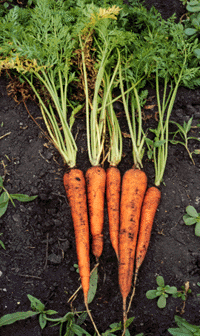
Carrot Production
By: Dean Knell
Many people in production agriculture are trying to express
the importance of niche markets. This is simply a market in which a person
or persons are targeting a specific audience in order to increase values
of their goods or to turn a profit. In North Dakota, we have relied on
these niche markets for many years.

Carrots grow best at mean temperatures between 60 and 70 F. During hot,
bright, sunny days young plants may be badly injured or killed by the high
temperatures that develop at or just below the soil surface. Prolonged
hot weather later in the development of the plants may not only retard
growth and depress yield, but may cause undesirable strong flavor and coarseness
in the roots. Temperatures much below 50 F tend to make the roots longer,
more slender, and paler in color than is typical.
To raise carrots as a cash crop, producers need to stretch out their planting
dates in order to avoid complete losses due to such things as weather and
insects. According to Iowa State University, small plantings every three
weeks will ensure a continuous harvest without the risk of losing an entire
crop. Carrots may be planted as late as August 1 for a fall crop.
As similar to other cash crops grown in mass production, diseases and
insects are a growing and never ending problem. In carrots, a few of the
more popular diseases are Alternaria leaf spot and Cercospora leaf spot.
Alternaria leaf spot and Cercospora leaf spot cause similar symptoms on
leaves and are difficult to distinguish in the field. Spots on leaves have
a dark center surrounded by a yellow margin. The leaves curl when lesions
appear on the edges of leaf segments. Both of these diseases can be controlled
by regular applications of fungicides. A few other diseases include: white
mold and aster yellows.
Depending of the year, insects can be very devastating to a carrot crop.
Grasshoppers, cutworms and aphids are predominantly the most common predators.
Insecticides can control many of the insects; however, strict health labels
make it very costly to apply such products.
Fresh-market carrot harvest can begin in August and extends
into mid-October. Undercutting the roots and elevating them out of the
soil and into the machine mechanically harvest carrots by grasping the
leaves. Thus, it is important to maintain healthy leaves until the carrots
are harvested.
Carrot production in North Dakota is slowing catching on. There has been a significant increase in the production of vegetables due to the invention of cool-season varieties. Most of the carrots grown in North Dakota are raised in the southern part of the Red River Valley. Economic and cash flow budget show that carrots can gross as much as $287.00/acre when grown in those areas. Consequently, the mass production of carrots could prove to be abright spot in agriculture for North Dakota.
Here are a few links that may give you some more insight
into the production of carrots:
http://www.ext.nodak.edu/extpubs/alt-ag/carrots.htm
http://www.hort.wisc.edu/usdavcru/simon/default.htm
http://www.public.iastate.edu/~taber/Extension/Carrots/carrots.html